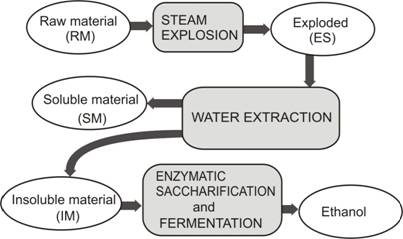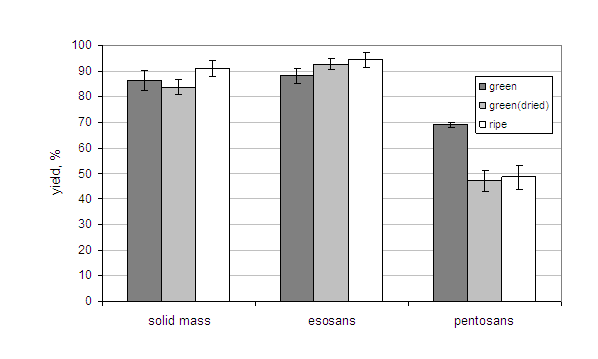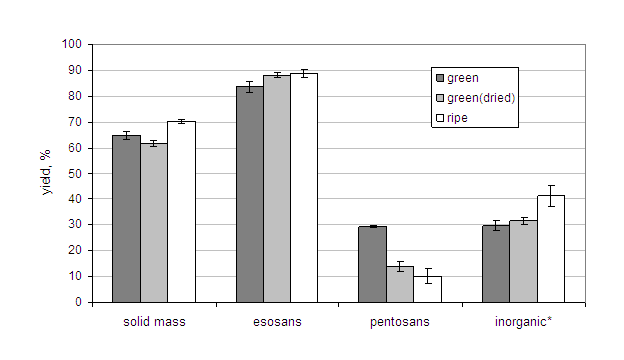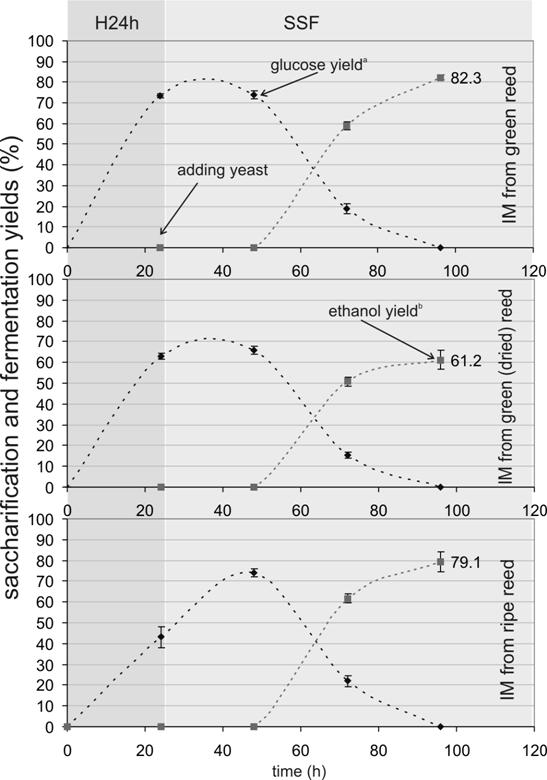The work highlighted the influence of the water content within the starting biomass, drying procedure and ripeness on the enzymatic digestibility of the giant reed, one of the most suitable nonfood crops for bioenergy and bio-compound production. Fresh green reed was treated as received, while oven-dried green and ripe reed were humidified before the steam explosion pretreatment that was carried out at 210 ℃ for 10 minutes. The exploded biomasses were extracted with water to remove the soluble hemicellulose and potential inhibitors; the insoluble residue was submitted to enzymatic hydrolysis and alcoholic fermentation. The process was evaluated in terms of sugars recovery and ethanol yield. After the sequence of pretreatment, enzymatic hydrolysis and fermentation by Saccharomyces cerevisiae 132 g; 103 g; 162 g of ethanol; and 77 g; 63 g; 92 g of pentosanes were respectively obtained from 1 kgDM of fresh green reed; dried green reed or ripe reed. The ripe reed contains more carbohydrates than the green reed and the resulting sugar and ethanol production was higher, in spite of lower saccharification yield. While drying the fresh biomass is good practice for biomass preservation, it negatively affects the recovery of free sugars and the ethanol production, because of fiber hornification which hinders enzyme access in the hydrolysis step.
1.
Introduction
For real numbers $ a, b, c $ with $ -c \notin \mathbb{N}\cup \left\{0\right\} $, the Gaussian hypergeometric function is defined by
where $ (a, 0) = 1 $ for $ a\neq0 $ and $ (a, n) $ is the shifted factorial function given by
for $ n\in \mathbb{N} $. It is well known that the Gaussian hypergeometric function, $ F(a, b; c; x) $, has a broad range of applications, including in geometric function theory, the theory of mean values, and numerous other areas within mathematics and related disciplines. Many elementary and special functions in mathematical physics are either particular cases or limiting cases. Specifically, $ F(a, b;c; x) $ is said to be zero-balanced if $ c = a+b $. For the case of $ c = a+b $, as $ x\to 1 $, Ramanujan's asymptotic formula satisfies
where
is the classical beta function [1] and
here $ \Psi(z) = \Gamma'(z)/\Gamma(z) $, $ Re(x) > 0 $ is the psi function, and $ \gamma $ is the Euler–Mascheroni constant [1].
Throughout this paper, let $ a\in \lbrack \frac{1}{2}, 1) $, and we denote $ r' = \sqrt{1-r^2} $ for $ r\in (0, 1) $. The generalized elliptic integrals of the first and second kind are defined on $ (0, 1) $ as follows [2]:
and
Set $ \mathcal{K}_a'(r) = \mathcal{K}_a(r'), \; \mathcal{E}_a'(r) = \mathcal{E}_a(r') $. Note that when $ a = \frac{1}{2} $, $ \mathcal{K}_a(r) $ and $ \mathcal{E}_a(r) $ reduce to the classical complete elliptic integrals $ \mathcal{K}(r) $ and $ \mathcal{E}(r) $ of the first and second kind, respectively
It is well known that complete elliptic integrals play a crucial role in various areas of mathematics and physics. In particular, these integrals provide a foundation for investigating numerous special functions within conformal and quasiconformal mappings, including the Grötzsch ring function, Hübner's upper bound function, and the Hersch–Pfluger distortion function[3,4]. In 2000, Anderson, et al. [5] reintroduced the generalized elliptic integrals in geometric function theory. They discovered that the generalized elliptic integral of the first kind, denoted as $ \mathcal{K}_a $, originates from the Schwarz–Christoffel transformation [3] of the upper half–plane onto a parallelogram and established several monotonicity theorems for $ \mathcal{K}_a $ and $ \mathcal{E}_a $. The generalized Grötzsch ring function in generalized modular equations and the generalized Hübner upper bound function can also be expressed in terms of generalized elliptic integrals[6]. Recently, generalized elliptic integrals have garnered significant attention from mathematicians. A wealth of properties and inequalities for these integrals can be found in the literature. Specifically, various properties of elliptic integrals and hypergeometric functions, including monotonicity, approximation, and discrete approximation, have been investigated in [7,8,9], with sharp inequalities derived for elliptic integrals. Additionally, studies in [10,11] primarily focus on inequalities between different means, such as the Toader mean, and Hölder mean, as well as their applications in elliptic integrals.
For $ r\in(0, 1) $, $ r' = \sqrt{1-r^2} $, it is known that the arc-length of an ellipse with semiaxes 1 and $ r $, denoted as $ L(1, r) $, is given by $ L(1, r) = 4\mathcal{E}(r') $. Muir indicated that $ L(1, r) $ can be approximated by $ 2\pi\{\left(\frac{1+r^{\frac{3}{2}}}{2}\right)^{\frac{2}{3}} $. Later, Vuorinen conjectured the following inequality for $ r\in(0, 1) $:
which was subsequently proven by Barnard et al.[12].
The Hölder mean of positive numbers $ x, y > 0 $ with order $ s\in \mathbb{R} $, is defined as
It is easy to see $ H_s(x, y) $ is strictly increasing with respect to $ s $. Alzer and Qiu [13] established the following inequalities:
with the best constants $ s_1 = 3/2 $ and $ s_2 = \log2/\log(\pi/2) = 1.5349\dots $, see [13,14] for details.
The generalized weighted Hölder mean of positive numbers $ x, y $, with weight $ \omega $ and order $ s $, is defined as [14]:
Wang et al. [15] proved that for $ r\in(0, 1) $, the following inequality holds:
and the best parameters $ \alpha = \alpha(s) $, $ \beta = \beta(s) $ satisfy
where $ s_0 = \frac{\log2}{\log(2/\pi)} = 1.5349\dots $, $ \eta = F_s(r_0) > \frac{1}{2} $, $ F_s = \frac{1-[2\mathcal{E}(r)/\pi]^s}{1-r'^s} $, and $ r_0 = r_0(s)\in(0, 1) $ is the value such that $ F_s(r) $ is strictly increasing on $ (0, r_0) $ and strictly decreasing on $ (r_0, 1)) $ for $ s\in(\frac{3}{2}, 2) $.
The extension of the inequality (1.6) to the second kind of generalized elliptic integral $ \mathcal{E}_a $, where $ a\in \lbrack \frac{1}{2}, 1) $, is a natural inquiry. This paper aims to address this question. One might wonder why the parameter $ a $ is restricted to the interval $ \left[ \frac{1}{2}, 1 \right) $ rather than $ (0, 1) $. For $ a \in (0, \frac{1}{2}) $, our analysis has revealed a lack of the expected monotonicity in the function $ \mathcal{F}_{a, p}(x) $, as defined in Theorem 3.1. This monotonicity is crucial for establishing the desired inequalities.
To achieve our purpose, we require some more properties of generalized elliptic integrals of the first and second kind. Therefore, Section 2 will introduce several lemmas that establish these properties. Section 3 will present our main results along with their corresponding proofs. In Section 4, we establish several functional inequalities involving $ \mathcal{E}_a $ as applications. Finally, we give the conclusion of this article.
2.
Lemmas
In this section, several key formulas and lemmas are presented to support the proof of the main results. The derivative formulas of the generalized elliptic integrals are given.
Lemma 2.1 ([5]). For $ a\in (0, 1) $ and $ r\in (0, 1) $, we have
The following lemma provides the monotonicity of some generalized elliptic integrals with respect to $ r $, which can be found in [16].
Lemma 2.2. Let $ a\in (0, 1) $. Then the following function:
(1) $ r \mapsto {\frac{\mathcal{E}_a-r'^2\mathcal{K}_a}{r^2}} $ is increasing from $ (0, 1) $ to $ (\frac{\pi a}{2}, \frac{\sin(\pi a)}{2(1-a)}) $;
(2) $ r \mapsto {\frac{\mathcal{E}_a-r'^2\mathcal{K}_a}{r^2\mathcal{K}_a}} $ is decreasing from $ (0, 1) $ to $ (0, a) $;
(3) $ r \mapsto {\frac{r'^2(\mathcal{K}_a-\mathcal{E}_a)}{r^2\mathcal{E}_a}} $ is decreasing from $ (0, 1) $ to $ (0, 1-a) $;
(4) $ r \mapsto {\frac{\mathcal{K}_a-\mathcal{E}_a)}{r^2\mathcal{K}_a}} $ is increasing from $ (0, 1) $ to $ (1-a, 1) $;
(5) $ r \mapsto {\frac{r'^c(\mathcal{K}_a-\mathcal{E}_a)}{r^2}} $ is decreasing on $ (0, 1) $ if and only if $ c\geq a(2-a) $.
Lemmas 2.3 and 2.4 are important tools for proving the monotonicity of the related functions.
Lemma 2.3 ([17]). Let $ \alpha(x) = \sum_{n = 0}^{\infty}a_nx^n $ and $ \beta(x) = \sum_{n = o}^{\infty}b_nx^n $ be real power series that converge on $ (-r, r)(r > 0) $, and $ b_n > 0 $ for all $ n $. If the sequence $ \{\frac{a_n}{b_n}\}_{n\geq0} $ is increasing (or decreasing) on $ (0, r) $, then so is $ \frac{\alpha(x)}{\beta(x)} $.
Lemma 2.4 ([3]). For $ a, b \in (-\infty, \infty) $ and $ a < b $, let $ f, g:[a, b] $ be continuous on $ [a, b] $ and be differentiable on $ (a, b) $, and $ g'(x) \neq 0 $ for all $ x\in (a, b) $. If $ \frac{f'(x)}{g'(x)} $ is increasing (or decreasing) on $ (a, b) $, then so are
In particular, if $ f(a) = g(a) = 0(or\; f(b) = g(b) = 0) $, then the monotonicity of $ \frac{f(x)}{g(x)} $ is the same as $ \frac{f'(x)}{g'(x)} $.
However, $ \frac{f'(x)}{g'(x)} $ is not always monotonic; it is sometimes piecewise monotonic. An auxiliary function $ H_{f, g} $ [8] is defined as
where $ f $ and $ g $ are differentiable on $ (a, b) $ and $ g'\neq 0 $ on $ (a, b) $ for $ -\infty < a < b < \infty $. If $ f $ and $ g $ are twice differentiable on $ (a, b) $, the function $ H_{f, g} $ satisfies the following identities:
Here, $ H_{f, g} $ establishes a connection between $ \frac{f}{g} $ and $ \frac{f'}{g'} $.
Lemma 2.5. Define the function $ f_1(x) $ on $ \lbrack \frac{1}{2}, 1) $ by
Then $ 2-x < {f_1(x)} < 2 $.
Proof. To establish the right-hand side of the inequality, it suffices to prove that
Denote
By differentiation, we obtain
Observe that $ g''_1(\frac{1}{2}) = \pi^2-10 = -0.130... < 0 $, and $ \lim\limits_{x\to 1^-}g''_1(x) = +\infty $. This implies that there exists $ x_0\in \lbrack\frac{1}{2}, 1) $ such that $ g'_1(x) $ is decreasing on $ \lbrack\frac{1}{2}, x_0) $ and increasing on $ (x_0, 1) $. Since $ g'_1(\frac{1}{2}) = \log2-1 = -0.306\dots, $ and $ g'_1(1^-) = 0, $ it is clear that
which implies that $ g_1(x) $ is decreasing on $ \lbrack \frac{1}{2}, 1) $. Consequently,
In order to establish the left-hand side of the inequality, we define
Note
Differentiating $ g_2(x) $ yields
Observe that
Based on these observations and the intermediate value theorem, there exists $ x_2\in \lbrack \frac{1}{2}, 1) $ such that $ g'_2(x_2) = 0 $ and $ g_2(x) $ is decreasing on $ \lbrack\frac{1}{2}, x_2) $ and increasing on $ (x_2, 1) $. Therefore, together with (2.4), we conclude that
This completes the proof. □
Lemma 2.6. For each $ a\in \lbrack\frac{1}{2}, 1) $, the function
is decreasing from $ (0, 1) $ to $ \left(0, \frac{a}{2-a}\right) $.
Proof. Following from (1.2) and (1.3), we deduce that
To establish the desired monotonicity of $ f_2(r) $, it suffices to prove that the function $ f_3(x) $, defined on (0, 1) by
is decreasing on $ (0, 1) $, where $ p(a) = \frac{2-a(2-a)}{2} $. Using the power series expansion, the function can be expressed as
where the coefficients $ U_n $ and $ V_n $ satisfy the recursive relations, as detailed in [18]:
with
By Lemma 2.3, we aim to prove that the sequence $ \left\{\frac{{U_n}}{{V_n}}\right\}_{n\geq0} $ is decreasing. Note that
and
Observe that
which implies
Assuming that $ U_{k}-\frac{V_{k}}{V_{k-1}}{U_{k-1}} < 0 $ for all $ 1 \leq k\leq n $, we prove by induction that $ U_{n+1}-\frac{V_{n+1}}{V_{n}}{U_{n}} < 0 $. According to (2.5), we have
Since $ a\in \lbrack \frac{1}{2}, 1) $, it is easy to know that
and
is positive for $ a\in \lbrack \frac{1}{2}, 1) $ when $ n\geq 1 $. For $ a\in \lbrack \frac{1}{2}, 1) $ and $ n\geq 1 $, we have that
where
In fact, $ \delta(n) $ is a quadratic function of $ n $ and is decreasing on $ (1, \infty) $, it follows that
which implies that
By induction, we conclude that $ U_{n+1}-\frac{V_{n+1}}{V_{n}}{U_{n}} < 0 $ for all $ n\geq1 $. Therefore, the sequence $ \left\{\frac{{U_n}}{{V_n}}\right\}_{n\geq0} $ is decreasing. Consequently, the function $ f_2(r) $ is decreasing on $ (0, 1) $. Moreover,
This completes the proof. □
Lemma 2.7. For each $ a\in \lbrack\frac{1}{2}, 1) $, we define the function $ h(r) $ on $ (0, 1) $ by
Then, $ 2-a < h(r) < 2 $.
Proof. First of all, we prove the right-hand side inequality. To establish the desired result, we need to show the following inequality:
which is equivalent to
Denote that
By differentiation, we obtain
Therefore, $ h_1(r) $ is decreasing on $ (0, 1) $ and
which implies $ h(r) < 2 $.
Next, we prove $ h(r) > 2-a $. This is equivalent to the following inequality.
Denote
The derivative of $ F(r) $ yields
Note that $ (\mathcal{E}_a-r'^2\mathcal{K}_a-ar^2\mathcal{E}_a)/r'^2 $ is increasing from (0, 1) to $ (0, \infty) $. In fact, by differentiation, we know
According to Lemma 2.2(1)(5) and Lemma 2.6, we have that $ F'(r) $ is increasing on (0, 1) and $ F'(r) > \lim\limits_{r\to0^+}F'(r) = 0 $, which implies that $ F(r) $ is increasing on $ (0, 1) $. Moreover,
Thus, $ h(r) > 2-a $. The proof is completed. □
For $ a\in\left[\frac{1}{2}, 1\right) $, it is also found that $ h(r) $ is strictly increasing on $ (0, 1) $.
Lemma 2.8. For each $ a\in \lbrack\frac{1}{2}, 1) $, $ r\in(0, 1) $, we define the function $ f_4(r) $ by
Then $ f_4(r) $ is strictly decreasing from $ (0, 1) $ to $ \left(0, \frac{(1-a)\pi}{2a(2-a)}\right) $.
Proof. Let
With Lemma 2.4 and $ f_{41}(0^+) = f_{42}(0^+) = 0 $, we only prove the monotonicity of $ f'_{41}(r)/f'_{42}(r) $. Then we have
By differentiation, we see
With Lemma 2.2(2), we obtain
Thus, $ f_{43}(r) $ is strictly decreasing on $ (0, 1) $, which shows $ f_4(r) $ is strictly decreasing. And
The proof is completed. □
Lemma 2.9. For each $ a\in \lbrack\frac{1}{2}, 1) $, $ r\in(0, 1) $, we define the function $ f_5(r) $ by
Then $ f_5(r) $ is strictly increasing from $ (0, 1) $ to $ \left(\frac{\pi}{2}, +\infty\right) $.
Proof. Let
Taking the derivative, we have
where
In fact, we see
which demonstrates $ f'_5(r) > 0 $ for $ r\in(0, 1) $ and $ f_5(r) $ is increasing on $ (0, 1) $. Moreover,
The proof is completed. □
Lemma 2.10. For each, $ a\in \lbrack\frac{1}{2}, 1) $, $ r\in(0, 1) $, $ h(r) $ is given as in Lemma 2.7. Then, $ h(r) $ is strictly increasing from $ (0, 1) $ to $ (2-a, 2) $.
Proof. Let
Clearly, $ h(r) = \frac{h_2(r)}{h_3(r)} $ and $ h_2(0^+) = h_3(0^+) = 0 $. By differentiations,
Then,
With Lemmas 2.8 and 2.9, we obtain that $ h(r) $ is strictly increasing on $ (0, 1) $. Furthermore,
This completes the proof. □
3.
Main results
In this section, we present some of the main results of $ \mathcal{E}_a(r) $.
Theorem 3.1. Let $ a \in \left[\frac{1}{2}, 1\right) $, $ p \in \mathbb{R} \setminus \left\{0\right\} $, and for $ r \in (0, 1) $, define
The monotonicity of $ \mathcal{F}_{a, p}(r) $ is as follows:
(1) $ \mathcal{F}_{a, p}(r) $ is strictly increasing from $ (0, 1) $ to $ (1-a, 1-b) $ if and only if $ p \geq 2 $, where
(2) $ \mathcal{F}_{a, p}(r) $ is strictly decreasing on $ (0, 1) $ if and only if $ p \leq 2-a $. Moreover, if $ p\in(0, 2-a\rbrack $, the range of $ \mathcal{F}_{a, p}(r) $ is $ (1-b, 1-a) $, and the range is $ (0, 1-a) $ if $ p\in(-\infty, 0) $.
(3) If $ p \in (2-a, 2) $, $ \mathcal{F}_{a, p}(r) $ is piecewise monotonic. To be precise, there exsists $ r_0 = r_0(a, p) \in (0, 1) $ such that $ \mathcal{F}_{a, p}(r) $ is strictly increasing on $ (0, r_0) $ and strictly decreasing on $ (r_0, 1) $. Furthermore, for $ r \in (0, 1) $, if $ p \in (2-a, p_0) $, the range of $ \mathcal{F}_{a, p}(r) $ satisifies
while
if $ p \in \lbrack p_0, 2) $, where
Proof. For $ r\in (0, 1) $,
Clearly, we have $ \varphi_1(0) = \varphi_2(0) = 0 $. By differentiation,
and
By differentiating $\log \varphi_3(r)$, we obtain
where $ h(r) $ is defined as in Lemma 2.7. By Lemmas 2.2(2), 2.7, and 2.10, there are three cases to consider.
$ (i) $ If $ p\geq 2. $ It follows from (3.3) that $ \varphi_3(r) $ is strictly increasing on $ (0, 1) $, and so is $ \mathcal{F}_{a, p}(r) $. Furthermore, in this case,
$ (ii) $ If $ p\leq 2-a $, as in the proof of case $ (i) $, we know that $ \varphi_3(r) $ is strictly decreasing on $ (0, 1) $, and so is $ \mathcal{F}_{a, p}(r) $. Also, $ \mathcal{F}_{a, p}(0^+) = 1-a $, and
$ (iii) $ If $ 2-a < p < 2 $. According to Ramanujan's approximation (1.1), it shows that $ r'^c\mathcal{K}_a \to 0 $ ($ r \to 1^{-} $) if $ c\geq 0 $. With Lemma 2.2(4) and the equation
we obtain
Together with (3.3), (3.4), Lemmas 2.7 and 2.10, and the formulas
which follows from (2.2) and (2.3), it shows that there exists $ r_0\in(0, 1) $ such that $ H_{\varphi_1, \varphi_2}(r) > 0 $ for $ r \in (0, r_0) $ and $ H_{\varphi_1, \varphi_2}(r) < 0 $ for $ r \in (r_0, 1) $. Thus, $ \mathcal{F}_{a, p}(r) $ is strictly increasing on $ (0, r_0) $ and strictly decreasing on $ (r_0, 1) $. Therefore, for all $ r\in(0, 1) $, we get
In fact, $ \mathcal{F}_{a, p}(r_0)\geq \mathcal{F}_{a, p}(r) > \text{max}{\left\{\mathcal{F}_{a, p}(0^+), \mathcal{F}_{a, p}(1^-)\right\}} $. It follows from Lemma 2.5 that
which makes $ p_0 $ the unique root of
on $ (2-a, 2) $ and $ p \mapsto 1-\left(\frac{\sin(\pi a)}{(1-a)\pi}\right)^{{\frac{p}{2(1-a)}}} $ is strictly increasing on $ (-\infty, \infty) $. Hence we have $ \mathcal{F}_{a, p}(0^+) \geq \mathcal{F}_{a, p}(1^-) $ if $ p\in(2-a, p_0\rbrack $ and $ \mathcal{F}_{a, p}(0^+) < \mathcal{F}_{a, p}(1^-) $ if $ p \in (p_0, 2) $. Consequently, the range of $ \mathcal{F}_{a, p}(r) $ in case 3 is valid. The proof is completed. □
Figure 1 shows the monotonicity of $ \mathcal{F}_{a, p} $ with $ a = 0.7 $ as an example.
Applying the property of $ \mathcal{F}_{a, p}(r) $ from Theorem 3.1, we obtain our main result.
Theorem 3.2. For $ a \in \lbrack \frac{1}{2}, 1) $, let $ \mu, \nu \in [0, 1] $ and $ p_0, \sigma_0 $ be given as in Theorem 3.1. Then for any fixed $ p\in \mathbb{R} $, the double inequality
holds for all $ r\in (0, 1) $ with the equality only for certain values of $ r $ if and only if $ \mu \leq \mu(a, p) $ and $ \nu \geq \nu(a, p) $, where $ \mu(a, p) $ and $ \nu(a, p) $ satisfy
where
Particularly, for $ p = 0 $, (3.5) holds if and only if $ \mu \leq 1-2(1-a)^2 $ and $ \nu \geq 1 $.
Proof. First we consider the case of $ p \neq 0 $, by (1.5), the inequality (3.5) is equivalent to
where $ F_{a, p}(r) $ is defined as in Theorem 3.1. It follows from Theorem 3.1 that we immediately conclude the best possible constants $ \mu = \mu(a, p) $ and $ \nu = \nu(a, p) $ in (3.6).
For $ p = 0 $, we define the function $ T(r) $ on (0, 1) by
Obviously, we see that $ T_1(0^+) = T_2(0^+) = 0 $. By differentiation, we have
Together with Lemma 2.2(3), this implies $ \frac{T'_1(r)}{T'_2(r)} $ is strictly decreasing on (0, 1), and by Lemma 2.4, $ T(r) $ shares the same monotonicity. Clearly, $ T(1^-) = 0 $ and
which indicates $ 1-2(1-a)^2 < 1-T(r) < 1 $ for $ r\in(0, 1) $. As a result, Eq (1.5) demonstrates that the inequality
holds for all $ r\in(0, 1) $ if and only if $ \mu\leq 1-2(1-a)^2 $ and $ \nu \geq 1 $.
This completes the proof. □
Figure 2 shows the sharpness of the bound with $ a = 0.7 $ as an example.
Remark 3.1. For $ a = \frac{1}{2} $, we see that (3.5) holds if the parameters satisfy the conditions given in Theorem 3.2. This conclusion has been proved in [15].
4.
Applications
In this section, by applying Theorem 3.2, we present several sharp bounds of weighted Hölder mean for $ \mathcal{E}_a $.
Note that for the case of $ \mu(a, p) = \nu(a, p) = a $, the best bounds of $ \mathcal{E}_a $ are attained at $ p = 2-a $ and $ p = p_0 $, which will be proved in the following corollary.
Corollary 4.1. Let $ a\in \lbrack\frac{1}{2}, 1) $ and $ p_1, p_2\in \mathbb{R} $. Then the inequality
holds for all $ r\in (0, 1) $ with the best possible constants $ p_1 = 2-a $ and $ p_2 = p_0 $, where $ p_0 $ is given as in Theorem 3.1.
Proof. For $ a\in [\frac{1}{2}, 1) $, we consider $ (\mu, p) = (a, 2-a) $ and $ (\nu, p) = (a, p_0) $ satisfying (3.6), which yields (4.1) upon substitution into (3.5).
To establish that $ a $ and $ p_0 $ are the best possible constants, we observe that the Hölder mean is monotonically increasing with respect to $ p $. Consequently, it suffices to analyze the case of $ 2-a < p < p_0 $.
According to Theorem 3.2, the inequality
holds for all $ r\in (0, 1) $, where $ 1-\sigma_0 $ and $ b $ are sharp, with $ b $ given as in Theorem 3.2. From Theorem 3.1, together with the monotonicity of $ \omega \mapsto H_p(1, r';\omega) $, we have $ 1-\sigma_0 < a < b $ for $ p\in(2-a, p_0) $, implying
Therefore, considering the sharpness of $ 1-\sigma_0 $ and $ b $ in inequality (4.2), we conclude that there exist two numbers $ r_1, r_2 \in (0, 1) $ such that
Thus, the proof is completed. □
Figure 3 demonstrates that the sharp bounds of $ \mathcal{E}_a $ are attained at $ p_1 = 2-a $ and $ p_2 = p_0 $ with $ a = 0.7 $ as an example.
Furthermore, it is observed that computing the lower bound in (3.6) for the case $ \mu(a, p) = 1-\sigma_0 $ is challenging, while the case $ \nu(a, p) = 1 $ is trivial. Thus, we propose using $ \mu(a, p) = b $ for $ p\in [2, \infty) $ and $ \nu(a, p) = b $ for $ p\in (0, p_0) $ to establish new bounds. The specific inequality is as follows.
Corollary 4.2. Inequality
holds for $ r\in (0, 1) $.
Lemma 4.3. Let $ a\in\lbrack\frac{1}{2}, 1) $,
Then, the function $ \Delta(p, r) $ with respect to $ p $ is strictly decreasing on $ (0, \infty) $ for $ r\in (0, 1) $.
Proof. By differentiating $ \log\Delta(p, r) $:
where
and
Differentiating $ \tilde{\Delta}(p, x) $ with respect to $ x $ yields
Give the observation that $ \Delta_0(p, x) $ is strictly decreasing for $ x\in(0, 1) $. In fact,
And
indicate that $ \tilde{\Delta}(p, x) $ first strictly increases on $ (0, x_0) $ and then strictly decreases on $ (x_0, 1) $ for some $ x_0\in (0, 1) $. Note that for $ p > 0 $, it is observed that
Hence, $ \tilde{\Delta}(p, x) > 0 $ for $ x \in (0, 1) $.
Consequently, monotonicity of $ \Delta(p, r) $ with respect to $ p $ follows from (4.4). □
Remark 4.1. Following Lemma 4.3 and inequality (3.5), we observe that
where
According to the proof of (3.2), if $ p\in(p_0, 2) $, it follows that
Therefore, it results in
by the monotonicity of $ H^{2(1-a)}_p(1, r';\zeta) $ with respect to $ \zeta $.Theorem 3.2 presents that, for $ p\in(p_0, 2) $, $ 1-\sigma_0 $ is sharp weight of $ H^{2(1-a)}_p(1, r';\zeta) $ as the lower bound of $ \mathcal{E}_a $, while $ a $ is sharp weight as the upper bound of $ \mathcal{E}_a $.
Hence, as a bound of $ \mathcal{E}_a $, $ H^{2(1-a)}_p(1, r';b) $ can attain the best upper bound at $ p = p_0 $ and the best lower bound at $ p = 2 $ by (4.6).
5.
Conclusions
In this article, we have proved the monotonicity of $ \mathcal{F}_{a, p}(r) $, where $ \mathcal{F}_{a, p}(r) $ is given as in Theorem 3.1. Moreover, we find the sharp weighted Hölder mean approximating $ \mathcal{E}_a $:
holds for all $ r\in (0, 1) $ if and only if $ \mu \leq \mu(a, p) $ and $ \nu \geq \nu(a, p) $, where $ \mu(a, p) $ and $ \nu(a, p) $ are given as in (3.6). Besides, we derive several bounds of $ \mathcal{E}_a $ in terms of weights and power, which are given by Corollary 4.1, Corollary 4.2, and Remark 4.1. These conclusions provide an extension of the work of [15].
Author contributions
Zixuan Wang: Investigation, Writing – original draft. Chuanlong Sun: Validation. Tiren Huang: Writing – review & editing. All authors have read and approved the final version of the manuscript for publication.
Use of Generative-AI tools declaration
The authors declare that they have not used artificial intelligence (AI) tools in the creation of this article.
Conflict of interest
The authors declare no conflicts of interest regarding the publication for the paper.
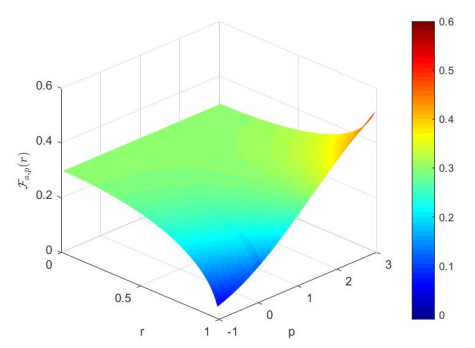









 DownLoad:
DownLoad:




